外研版(2019)必修第一册Unit 5 Developing ideas 课件-(36张ppt)
文档属性
| 名称 | 外研版(2019)必修第一册Unit 5 Developing ideas 课件-(36张ppt) | 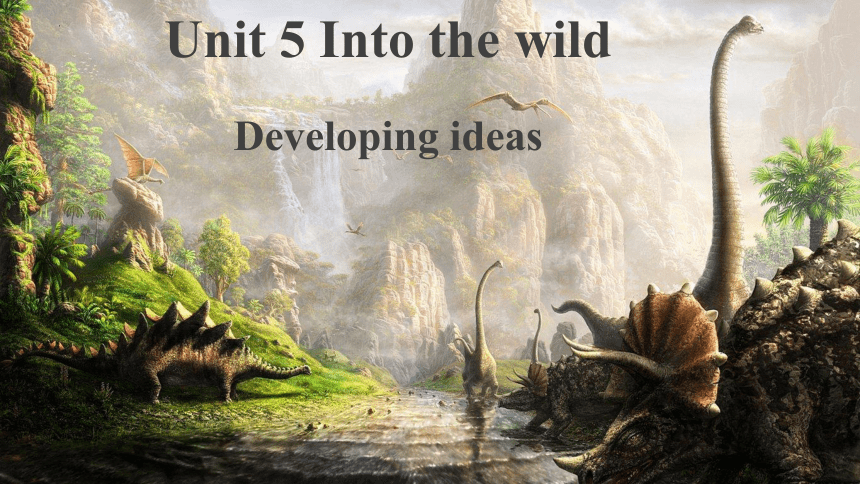 | |
| 格式 | pptx | ||
| 文件大小 | 7.0MB | ||
| 资源类型 | 教案 | ||
| 版本资源 | 外研版(2019) | ||
| 科目 | 英语 | ||
| 更新时间 | 2022-11-01 18:17:57 | ||
图片预览

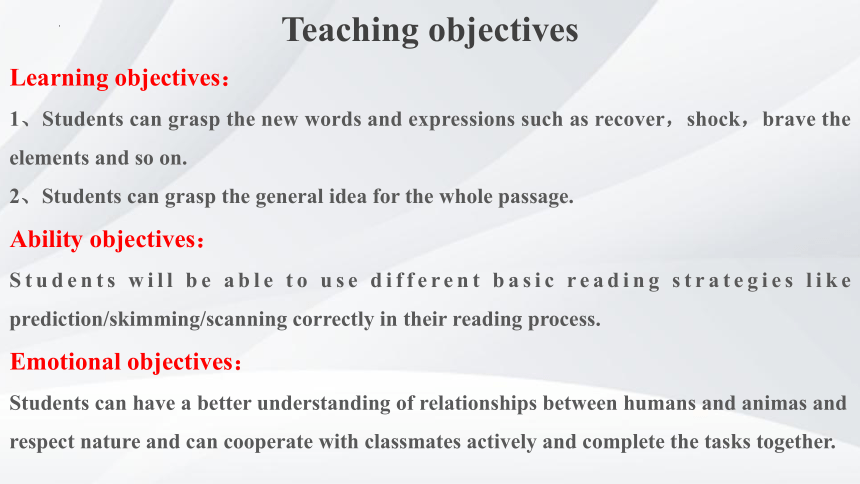
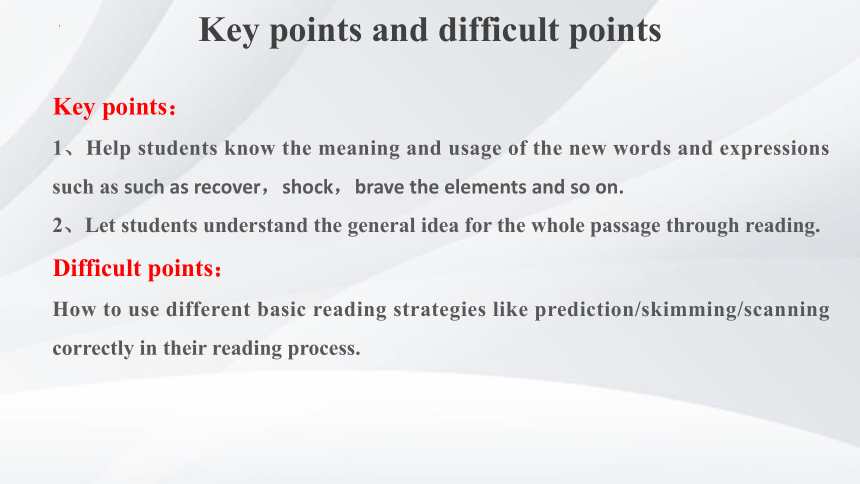
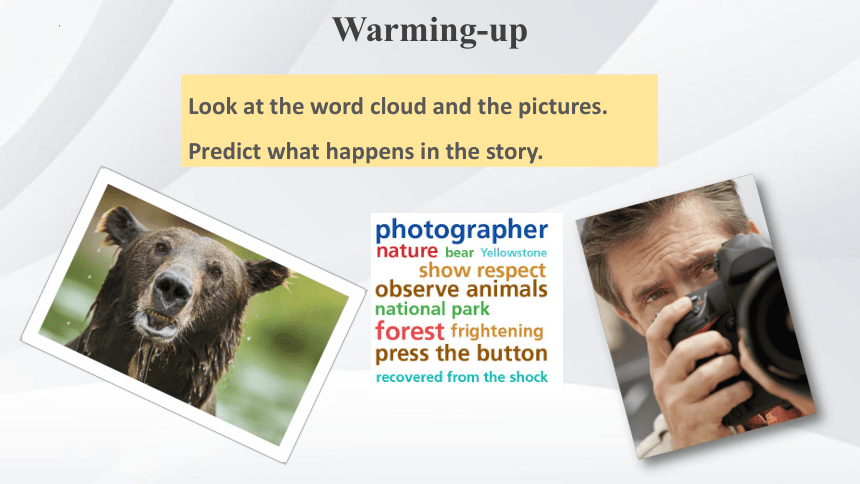

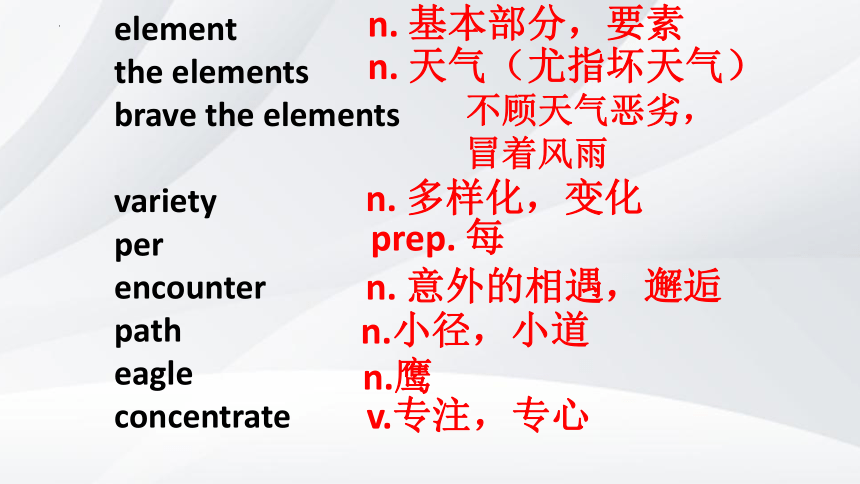

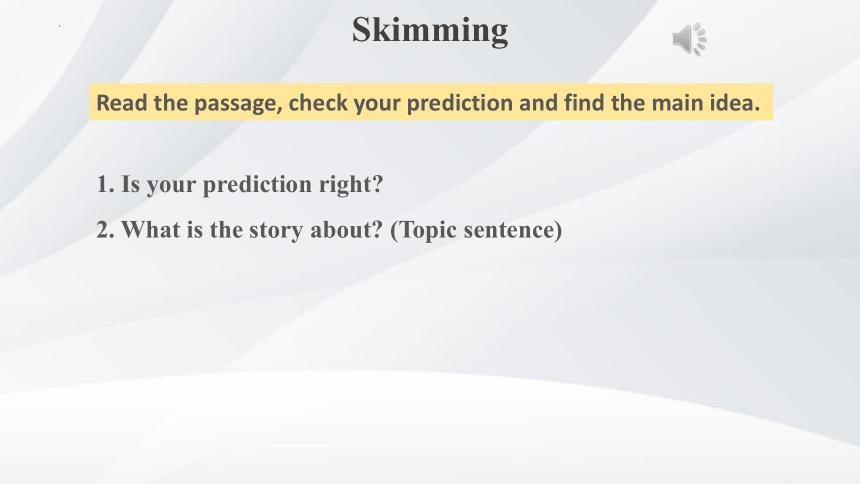
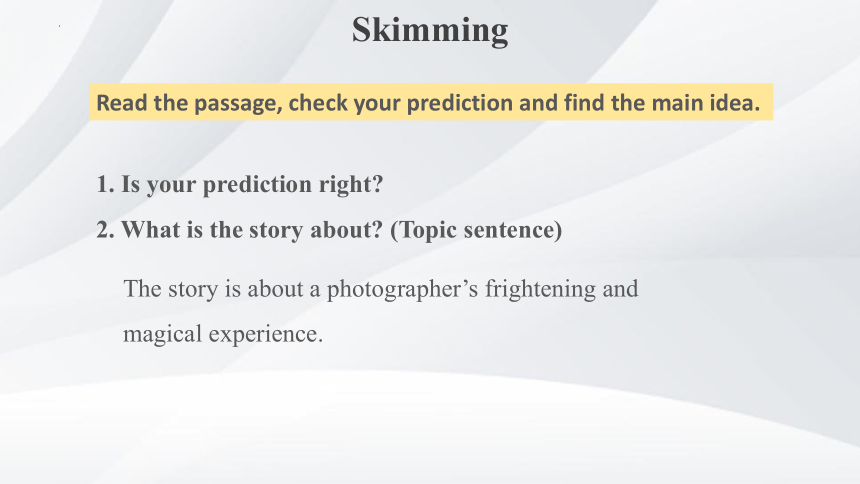
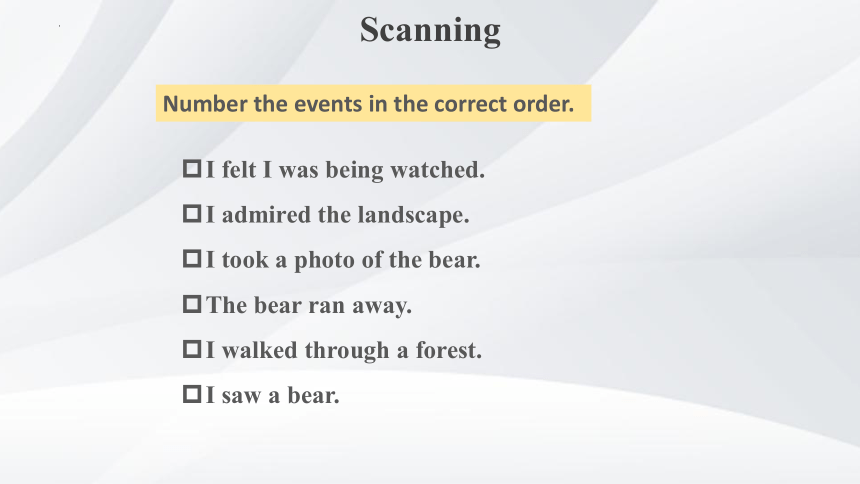
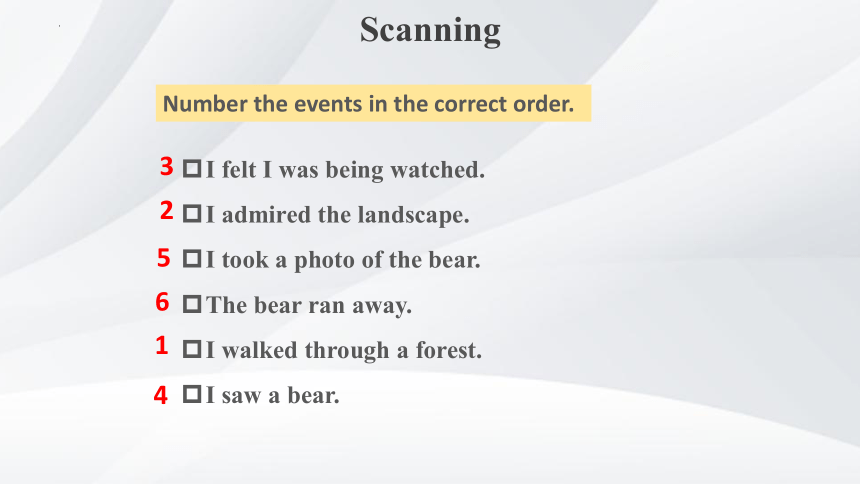
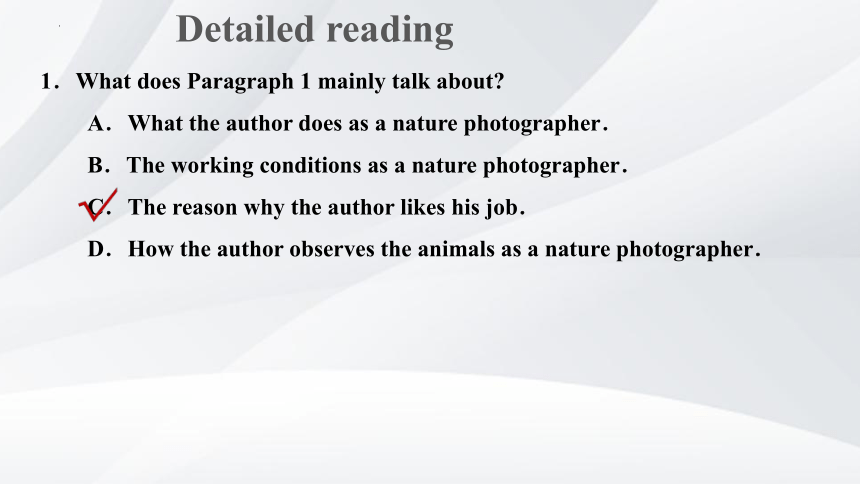
文档简介
(共36张PPT)
Unit 5 Into the wild
Developing ideas
Teaching objectives
Learning objectives:
1、Students can grasp the new words and expressions such as recover,shock,brave the elements and so on.
2、Students can grasp the general idea for the whole passage.
Ability objectives:
Students will be able to use different basic reading strategies like prediction/skimming/scanning correctly in their reading process.
Emotional objectives:
Students can have a better understanding of relationships between humans and animas and respect nature and can cooperate with classmates actively and complete the tasks together.
Key points and difficult points
Key points:
1、Help students know the meaning and usage of the new words and expressions such as such as recover,shock,brave the elements and so on.
2、Let students understand the general idea for the whole passage through reading.
Difficult points:
How to use different basic reading strategies like prediction/skimming/scanning correctly in their reading process.
Warming-up
Look at the word cloud and the pictures. Predict what happens in the story.
photographer
button
recover
shock
n. 摄影师
n. 按钮
v. (从糟糕的经历中)恢复
n. 吃惊,震惊
element
the elements
brave the elements
variety
per
encounter
path
eagle
concentrate
n. 基本部分,要素
n. 天气(尤指坏天气)
不顾天气恶劣,冒着风雨
n. 多样化,变化
n.小径,小道
n.鹰
prep. 每
n. 意外的相遇,邂逅
v.专注,专心
breathtaking
capture
v.(用文字或图片)记录,捕捉
adj. 令人惊叹的住
Skimming
1. Is your prediction right
2. What is the story about (Topic sentence)
Read the passage, check your prediction and find the main idea.
Skimming
1. Is your prediction right
2. What is the story about (Topic sentence)
The story is about a photographer’s frightening and magical experience.
Read the passage, check your prediction and find the main idea.
Scanning
Number the events in the correct order.
I felt I was being watched.
I admired the landscape.
I took a photo of the bear.
The bear ran away.
I walked through a forest.
I saw a bear.
Scanning
Number the events in the correct order.
I felt I was being watched.
I admired the landscape.
I took a photo of the bear.
The bear ran away.
I walked through a forest.
I saw a bear.
1
2
3
5
6
4
1.What does Paragraph 1 mainly talk about
A.What the author does as a nature photographer.
B.The working conditions as a nature photographer.
C.The reason why the author likes his job.
D.How the author observes the animals as a nature photographer.
Detailed reading
2.Which of the following is NOT true about Yellowstone National Park
A.It is the world's largest national park.
B.The park is famous for the variety of its wildlife.
C.Probably the park is best known for its bears.
D.The bears in the park can run very fast although on average they weigh up to 300 kilograms.
Detailed reading
3.The author often looks at the photo because __________.
A.it is a photo well taken
B.it is a reminder to show respect to all animals
C.it is a photo winning a prize
D.it is the last photo that the writer took
Detailed reading
Detailed Reading
1. When I finally stepped out of the trees, the view was breathtaking.
2. An eagle flew over the snow-capped mountains, which were reflected in the still lake below.
3. My most frightening but magical experience was now captured forever in a single image.
Read the sentences from the passage and work out the meaning of the words in bold.
Guessing tip:
When you read an unfamiliar word, make sure that you read the whole sentence. Try to work out what type of word it is (noun, adjective, verb, etc), then use the words before and after it to help you guess the meaning.
Reading
1. When I finally stepped out of the trees, the view was breathtaking.
2. An eagle flew over the snow-capped mountains, which were reflected in the still lake below.
3. My most frightening but magical experience was now captured forever in a single image.
“Breathtaking” means something is extremely beautiful or amazing, often in a surprising way.
“Reflected” means that images can be seen on the surface of the mirror, glass or water.
“Frightening” means that something is making people feel afraid, anxious or nervous.
Think and share
1. What difficulties do you think a nature photographer might encounter
2. What can we do to show our respect for animals
The weather condition is unpredictable, so they might face many challenges caused by extreme weather in the wild.
They may meet various wild animals, which is likely to put their lives in danger.
establishing nature reserve
taking full advantage of every opportunity to appeal to people to protect animals.
joint efforts made by government and individuals.
Group Discussion
groomer
zoologist
vet
police dog handler
Work in groups. Give a talk about a job that involves working with animals.
What does a groomer /
zoologist / vet / police dog
handler do
Discussion
groomer
to clean, trim, shape, and dye the hair / feathers / finger claws of all kinds of pets
to beautify and protect the appearance
to make pets healthier and more fashionable
Discussion
zoologist
scientists who study animals
research animal physiology, animal classification, animal ecology, animal domestication and so on
generally work in universities, biological research institutions, or natural museums
write reports or results into books for publication in journals
Discussion
vet
doctors who prevent, diagnose, and treat animals
a type of worker who uses medical methods to promote the coordination of animals with microorganisms and the natural environment
Discussion
police dog handler
to train the police dogs so as to make them complete a series of tasks
tasks such as anti-drug (缉毒), search for explosives (搜爆), rescue (营救), riot prevention (防暴), and tracking (追踪)
Discussion
Choose a job you would like to do and give your talk to the class by referring to the table below.
Pre-writing
1. What does the red-crowned crane look like
2. Where can you find it
3. Where does it migrate to
4. What does it eat
5. What symbolic meaning does the red-crowned crane have in Chinese culture
Read the paragraph about the red-crowned crane and answer the questions.
Pre-writing
1. What does the red-crowned crane look like
2. Where can you find it
It has white feathers except for some black ones on its face, neck and wings. It also has bright red skin on the top of its head.
It can be found in China, Russia, Mongolia, Japan and the Korean Peninsula.
Pre-writing
4. What does it eat
5. What symbolic meaning does the red-crowned crane have in Chinese culture
3. Where does it migrate to
It migrates to east-central China when the weather gets cold.
It eats fish, snails and water plants.
It has a symbolic meaning of long life and good luck in Chinese culture.
Writing
Writing an animal fact file
Useful Expressions:
It is… tall.
It gets its name from…
Its unique feature is…
Its food includes…
It is a symbol of…
Writing
Animal
Appearance
Habitat
Migration
Diet
Other information
Choose an animal you want to write about and make notes.
the Siberian crane (the snow crane)
140 cm in height
nearly all snowy white feathers, except for some black ones
red featherless face
East Asia
China or Iran
fish, insects, the roots and tubers of water plants, etc.
a symbol of elegance, purity, good fortune and long life
Writing
Writing guide
Writing
The Siberian crane is also known as the snow crane. It is about 140 cm in height, generally shorter than the red-crowned crane. Its feathers are nearly all snowy white except for some black ones that are only visible in flight. Its featherless face is reddish in colour. The Siberian crane is usually found in East Asia, where its numbers are known as the eastern populations. These migrate to China in winter. Other much smaller populations migrate to Iran in winter. The snow crane has a good and diverse appetite, including fish, insects, the roots and tubers of water plants and so on. In Chinese culture, the snow crane is a symbol of elegance, purity, good fortune and long life.
Sample
Assignment
Exchange the draft with your partner and try to improve each other’s writing.
1. One of the best things about this job is that you can observe animals in their natural environment.
observe vt. 观察;观测
observation n. 观察;观测
e.g. 儿童通过观察成年人来学习。
Children learn by observing adults.
Notes
2. As the world’s first national park, Yellowstone is famous for the variety of its wildlife, but it is probably best known for its bears.
be famous/be known for 意为“因……而出名”。
e.g. 浙江以茶叶和丝绸而闻名。
Zhejiang is famous for tea and silk.
variety n. 变化;多样性 various/a variety of/varieties of 多种多样的
e.g. 俱乐部给当地的青少年提供丰富多样的游戏。
The club offers a wide variety of games to the local teenagers.
Notes
3. While I was concentrating on photographing this amazing scene, I suddenly had a feeling that I was being watched .
concentrate on 意为“全神贯注于……”。
e.g. 当你全神贯注于一项任务时,你会完成得又快又好。
When you concentrate on one task you can get it done faster and better.
concentration n. 集中;专心
that 引导同位语从句,不能省略
Notes
4. Slowly, and with the camera still held to my eye, I turned… and froze.
with the camera held 为 “with + 宾语 + 过去分词”结构,该结构在句中作伴随状语。
with + 宾语 + 介词短语/形容词、副词
不定式(表示动作将要发生)
过去分词 (表示被动或完成)
现在分词 (表示主动或正在进行)
e.g. 有当地向导带路,我们很容易就到了那儿。
With a local guide leading the way, we got there easily.
Notes
Goodbye!
Unit 5 Into the wild
Developing ideas
Teaching objectives
Learning objectives:
1、Students can grasp the new words and expressions such as recover,shock,brave the elements and so on.
2、Students can grasp the general idea for the whole passage.
Ability objectives:
Students will be able to use different basic reading strategies like prediction/skimming/scanning correctly in their reading process.
Emotional objectives:
Students can have a better understanding of relationships between humans and animas and respect nature and can cooperate with classmates actively and complete the tasks together.
Key points and difficult points
Key points:
1、Help students know the meaning and usage of the new words and expressions such as such as recover,shock,brave the elements and so on.
2、Let students understand the general idea for the whole passage through reading.
Difficult points:
How to use different basic reading strategies like prediction/skimming/scanning correctly in their reading process.
Warming-up
Look at the word cloud and the pictures. Predict what happens in the story.
photographer
button
recover
shock
n. 摄影师
n. 按钮
v. (从糟糕的经历中)恢复
n. 吃惊,震惊
element
the elements
brave the elements
variety
per
encounter
path
eagle
concentrate
n. 基本部分,要素
n. 天气(尤指坏天气)
不顾天气恶劣,冒着风雨
n. 多样化,变化
n.小径,小道
n.鹰
prep. 每
n. 意外的相遇,邂逅
v.专注,专心
breathtaking
capture
v.(用文字或图片)记录,捕捉
adj. 令人惊叹的住
Skimming
1. Is your prediction right
2. What is the story about (Topic sentence)
Read the passage, check your prediction and find the main idea.
Skimming
1. Is your prediction right
2. What is the story about (Topic sentence)
The story is about a photographer’s frightening and magical experience.
Read the passage, check your prediction and find the main idea.
Scanning
Number the events in the correct order.
I felt I was being watched.
I admired the landscape.
I took a photo of the bear.
The bear ran away.
I walked through a forest.
I saw a bear.
Scanning
Number the events in the correct order.
I felt I was being watched.
I admired the landscape.
I took a photo of the bear.
The bear ran away.
I walked through a forest.
I saw a bear.
1
2
3
5
6
4
1.What does Paragraph 1 mainly talk about
A.What the author does as a nature photographer.
B.The working conditions as a nature photographer.
C.The reason why the author likes his job.
D.How the author observes the animals as a nature photographer.
Detailed reading
2.Which of the following is NOT true about Yellowstone National Park
A.It is the world's largest national park.
B.The park is famous for the variety of its wildlife.
C.Probably the park is best known for its bears.
D.The bears in the park can run very fast although on average they weigh up to 300 kilograms.
Detailed reading
3.The author often looks at the photo because __________.
A.it is a photo well taken
B.it is a reminder to show respect to all animals
C.it is a photo winning a prize
D.it is the last photo that the writer took
Detailed reading
Detailed Reading
1. When I finally stepped out of the trees, the view was breathtaking.
2. An eagle flew over the snow-capped mountains, which were reflected in the still lake below.
3. My most frightening but magical experience was now captured forever in a single image.
Read the sentences from the passage and work out the meaning of the words in bold.
Guessing tip:
When you read an unfamiliar word, make sure that you read the whole sentence. Try to work out what type of word it is (noun, adjective, verb, etc), then use the words before and after it to help you guess the meaning.
Reading
1. When I finally stepped out of the trees, the view was breathtaking.
2. An eagle flew over the snow-capped mountains, which were reflected in the still lake below.
3. My most frightening but magical experience was now captured forever in a single image.
“Breathtaking” means something is extremely beautiful or amazing, often in a surprising way.
“Reflected” means that images can be seen on the surface of the mirror, glass or water.
“Frightening” means that something is making people feel afraid, anxious or nervous.
Think and share
1. What difficulties do you think a nature photographer might encounter
2. What can we do to show our respect for animals
The weather condition is unpredictable, so they might face many challenges caused by extreme weather in the wild.
They may meet various wild animals, which is likely to put their lives in danger.
establishing nature reserve
taking full advantage of every opportunity to appeal to people to protect animals.
joint efforts made by government and individuals.
Group Discussion
groomer
zoologist
vet
police dog handler
Work in groups. Give a talk about a job that involves working with animals.
What does a groomer /
zoologist / vet / police dog
handler do
Discussion
groomer
to clean, trim, shape, and dye the hair / feathers / finger claws of all kinds of pets
to beautify and protect the appearance
to make pets healthier and more fashionable
Discussion
zoologist
scientists who study animals
research animal physiology, animal classification, animal ecology, animal domestication and so on
generally work in universities, biological research institutions, or natural museums
write reports or results into books for publication in journals
Discussion
vet
doctors who prevent, diagnose, and treat animals
a type of worker who uses medical methods to promote the coordination of animals with microorganisms and the natural environment
Discussion
police dog handler
to train the police dogs so as to make them complete a series of tasks
tasks such as anti-drug (缉毒), search for explosives (搜爆), rescue (营救), riot prevention (防暴), and tracking (追踪)
Discussion
Choose a job you would like to do and give your talk to the class by referring to the table below.
Pre-writing
1. What does the red-crowned crane look like
2. Where can you find it
3. Where does it migrate to
4. What does it eat
5. What symbolic meaning does the red-crowned crane have in Chinese culture
Read the paragraph about the red-crowned crane and answer the questions.
Pre-writing
1. What does the red-crowned crane look like
2. Where can you find it
It has white feathers except for some black ones on its face, neck and wings. It also has bright red skin on the top of its head.
It can be found in China, Russia, Mongolia, Japan and the Korean Peninsula.
Pre-writing
4. What does it eat
5. What symbolic meaning does the red-crowned crane have in Chinese culture
3. Where does it migrate to
It migrates to east-central China when the weather gets cold.
It eats fish, snails and water plants.
It has a symbolic meaning of long life and good luck in Chinese culture.
Writing
Writing an animal fact file
Useful Expressions:
It is… tall.
It gets its name from…
Its unique feature is…
Its food includes…
It is a symbol of…
Writing
Animal
Appearance
Habitat
Migration
Diet
Other information
Choose an animal you want to write about and make notes.
the Siberian crane (the snow crane)
140 cm in height
nearly all snowy white feathers, except for some black ones
red featherless face
East Asia
China or Iran
fish, insects, the roots and tubers of water plants, etc.
a symbol of elegance, purity, good fortune and long life
Writing
Writing guide
Writing
The Siberian crane is also known as the snow crane. It is about 140 cm in height, generally shorter than the red-crowned crane. Its feathers are nearly all snowy white except for some black ones that are only visible in flight. Its featherless face is reddish in colour. The Siberian crane is usually found in East Asia, where its numbers are known as the eastern populations. These migrate to China in winter. Other much smaller populations migrate to Iran in winter. The snow crane has a good and diverse appetite, including fish, insects, the roots and tubers of water plants and so on. In Chinese culture, the snow crane is a symbol of elegance, purity, good fortune and long life.
Sample
Assignment
Exchange the draft with your partner and try to improve each other’s writing.
1. One of the best things about this job is that you can observe animals in their natural environment.
observe vt. 观察;观测
observation n. 观察;观测
e.g. 儿童通过观察成年人来学习。
Children learn by observing adults.
Notes
2. As the world’s first national park, Yellowstone is famous for the variety of its wildlife, but it is probably best known for its bears.
be famous/be known for 意为“因……而出名”。
e.g. 浙江以茶叶和丝绸而闻名。
Zhejiang is famous for tea and silk.
variety n. 变化;多样性 various/a variety of/varieties of 多种多样的
e.g. 俱乐部给当地的青少年提供丰富多样的游戏。
The club offers a wide variety of games to the local teenagers.
Notes
3. While I was concentrating on photographing this amazing scene, I suddenly had a feeling that I was being watched .
concentrate on 意为“全神贯注于……”。
e.g. 当你全神贯注于一项任务时,你会完成得又快又好。
When you concentrate on one task you can get it done faster and better.
concentration n. 集中;专心
that 引导同位语从句,不能省略
Notes
4. Slowly, and with the camera still held to my eye, I turned… and froze.
with the camera held 为 “with + 宾语 + 过去分词”结构,该结构在句中作伴随状语。
with + 宾语 + 介词短语/形容词、副词
不定式(表示动作将要发生)
过去分词 (表示被动或完成)
现在分词 (表示主动或正在进行)
e.g. 有当地向导带路,我们很容易就到了那儿。
With a local guide leading the way, we got there easily.
Notes
Goodbye!
